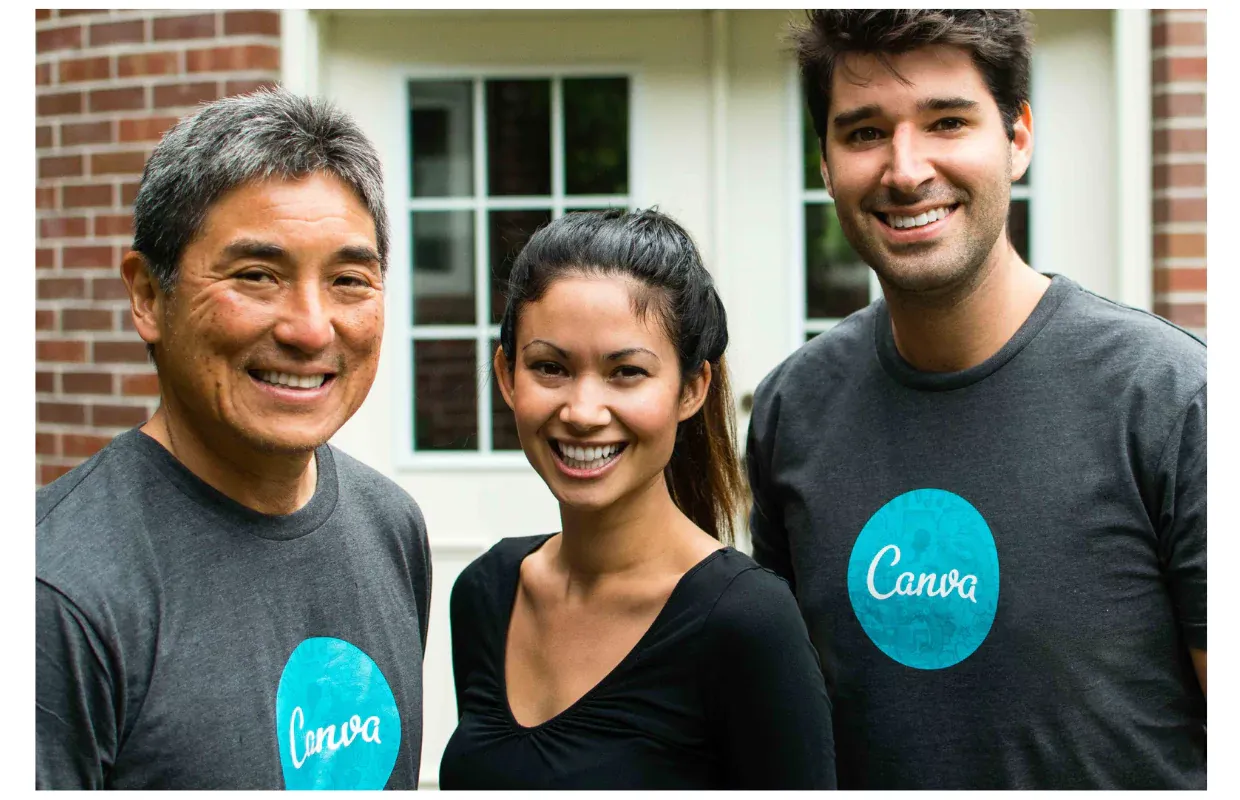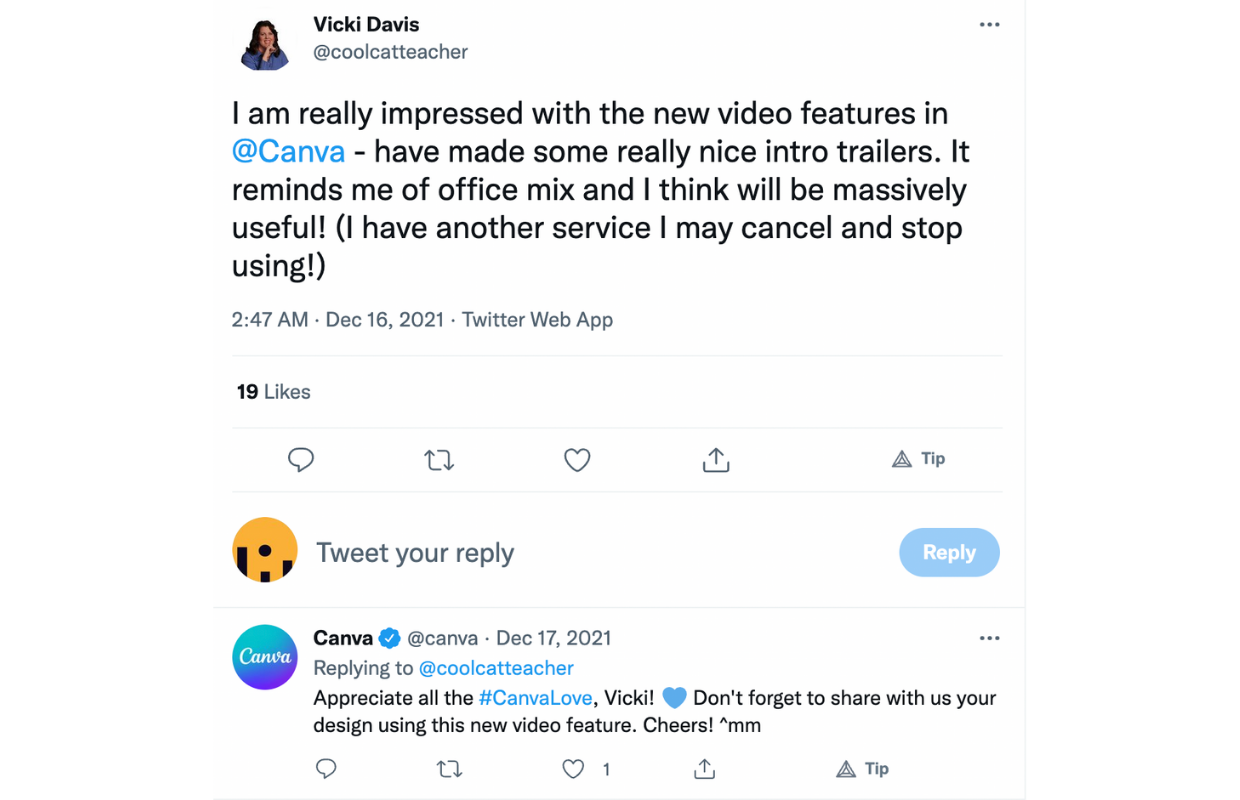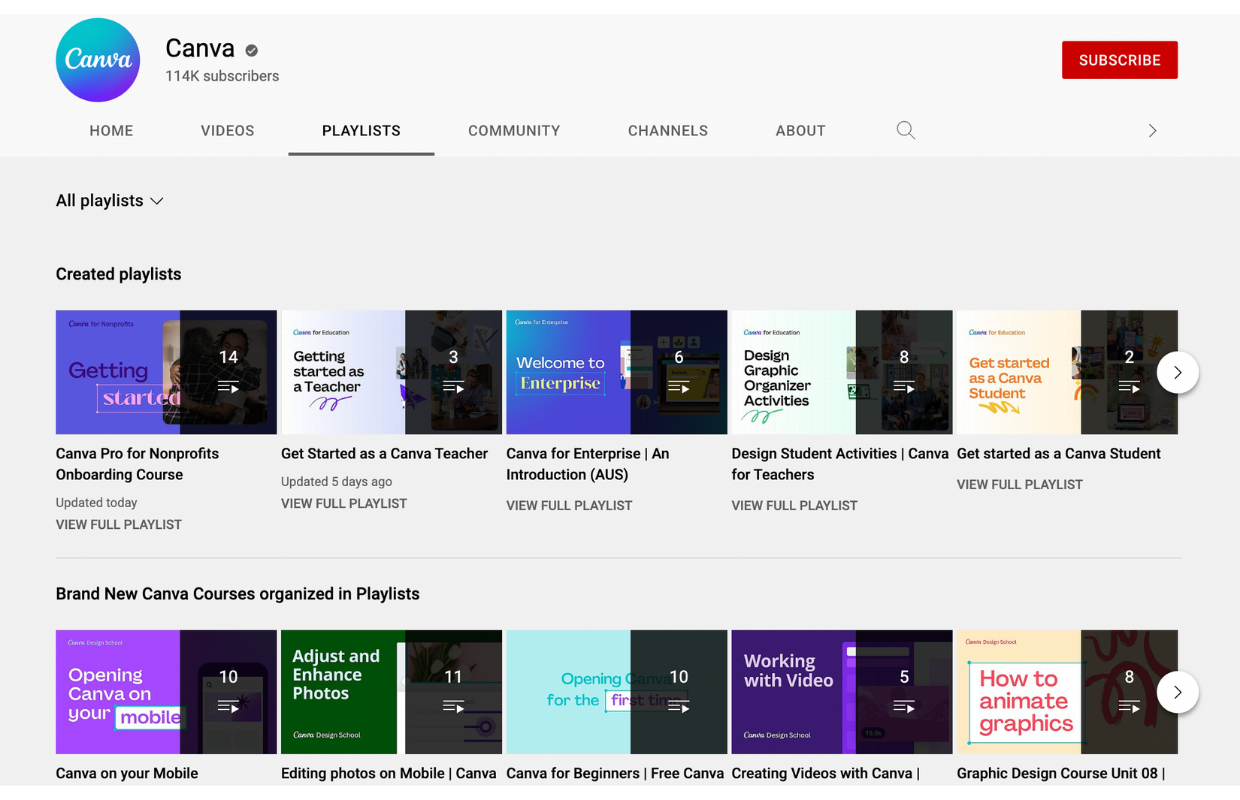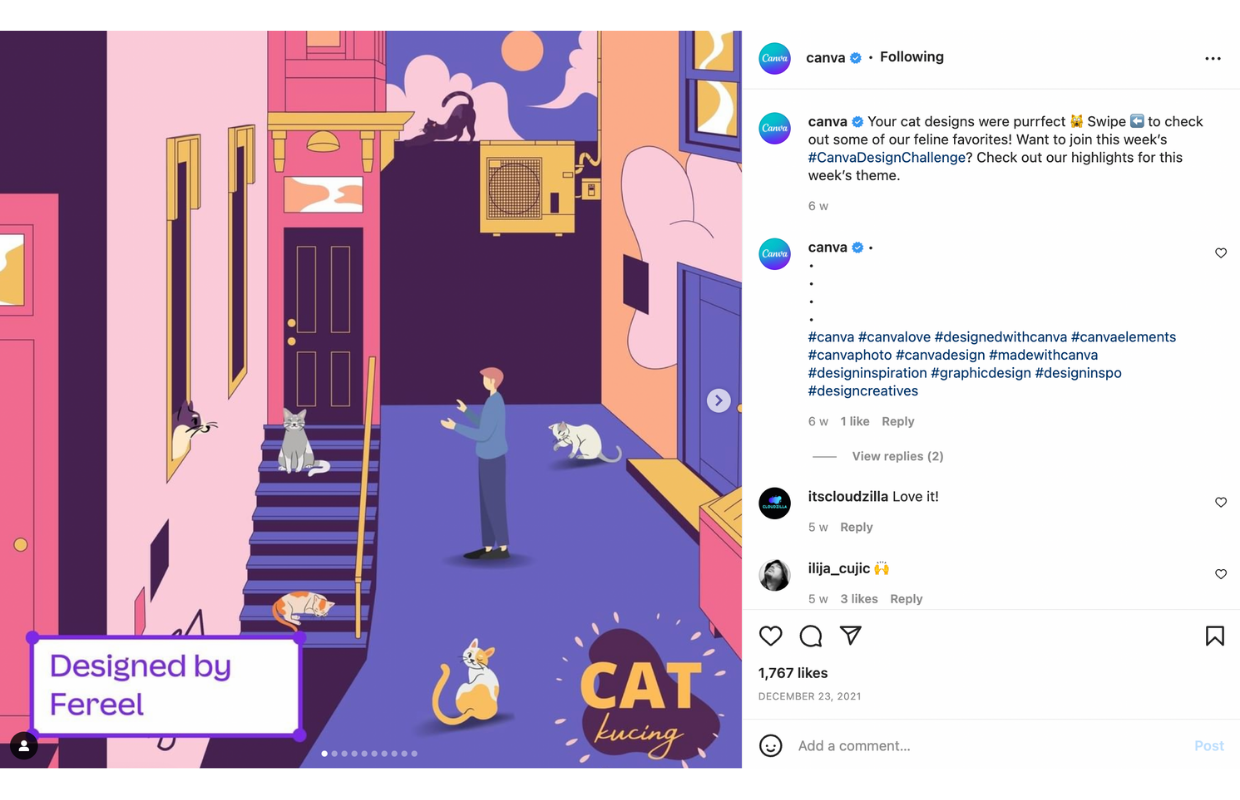We live in a world dominated by visual content. From TV and commercial advertisements to social media, visuals are the core of every aspect of our lives.
Studies have shown that the human brain understands visual information better. In fact, 90% of the information transmitted to the brain is visual.
This instinctive tendency of people towards visuals is best observed in social media, where the most successful types of content are images and videos.
Every business or content creator who wants to have a solid social media presence needs to constantly find ways of displaying unique and engaging visual content to their audiences.
But what about the people who don’t have the time or the funds to master complicated tools to become designers to create appealing visuals?
Or those who need the ability to create high-quality designs fast?
This is where Canva comes in.
In today’s brand analysis, I will look at my favorite tool’s social media strategy and analyze the marketing tactics that Canva has used to become the giant it is today.
Learn social media lessons by studying Canva's maketing strategy
- Content marketing
- Influencer advocacy
- Social proof
- Canva on Facebook
- Canva on Instagram
- Canva on YouTube
- “Enjoy your presentations”
- Canva Design Challenge
1. Learn more about the brand’s identity through some Canva statistics
Launched in 2013, Canva is a visual communication tool that is free to use, making design accessible for everyone.
The app offers a variety of drag and drop templates where you can create visual content, including social media posts and graphics, presentations, posters, documents, resumes, and more.
In less than seven years, Canva has acquired over 15 million users and has been valued at USD 40 billion after its latest fundraising round.
But Canva is more than its huge business success. It’s also one of the most beloved creative tools of social media people worldwide.

To deeply understand the brand’s expansion and usage of the app, let’s go over some Canva statistics that will reveal the brand’s position in the marketing world.
Below are some key Canva stats that will help you get a clearer picture of the brand:
- Canva has more than 60 million monthly active users across 190 countries
- More than 500,000 teams are paying for the tool
- Over 7 billion designs have been created in Canva until now
- On average, 50 Canva designs are created per second
- Canva was awarded the #1 best place to work in Australia in 2018
- Their global internet engagement is now in the top 100 as ranked by Amazon Alexa
- Canva has more than 3.5 billion images uploaded to the platform and 133 pieces of content are uploaded every second
- You can find more than 60,000 free templates in Canva
- According to Alexa, the highest source of traffic in Canva comes from the United States (24.6%), followed by India (22.8%), and Mexico (3.7%)
- Design creation and sharing on Canva has increased by over 50% since the start of the pandemic
- Canva receives traffic from direct (71.49%) and search (20.76%) and their most underutilized channel is "ads"
- Canva’s most keyword search traffic comes from organic (82.19%) and roughly from paid (17.81%)
- The top social media networks directing traffic to Canva are YouTube (27.11%), Facebook (27.01%), and WhatsApp Webapp (17.70%)
2. Discover the marketing strategy behind Canva
As Jacky Barker has pointed out in an episode from our podcast - Insider Insights - Canva is so loved by creatives because it empowers the world of design.
If in the past design was only something for graphic designers, with Canva, everyone can communicate their goals through visuals (whether it’s a resume for their dream job or a presentation pitch for a client).
Canva’s primary goal, according to Jacky, is to democratize design and make it accessible for everyone.
You don’t need to know design when using the tool because it offers a lot of predefined templates that are extremely fun and easy to work with.
In a nutshell, the brand’s vision of helping everyone create amazing designs in just a few clicks perfectly aligns with the collective need to find effective ways to make beautiful visuals.
Canva uses this vision in almost all its marketing campaigns with the framework known as “jobs to be done.” This is based on the idea that the users are trying to achieve something with the product.
For example, someone might want to create social media design graphics for their studies quickly.
Or someone might want to create a Facebook ad without the fuss of using a complicated tool like Photoshop.
Canva takes this general need of people working in creative fields and shows them that they can achieve their tasks as quickly as a flash.
Let’s break it down.
-
Content marketing
Besides creating cool digital tools to support users craft awesome designs, Canva also has an educational dimension, as it helps people improve their designing skills.
One of the marketing methods through which Canva directs its genuine effort to help people elevate their design capabilities is through content marketing.
There is no doubt that Canva drives traffic and conversion through its well-put-out and executed content marketing strategy.
The mix between a stellar SEO strategy, the diverse educational materials (blog posts, tutorials, and videos), and an honest intention of helping users it’s the guaranteed recipe for social media success.
Canva’s blog structure is centered around the idea of helping users achieve their design goals and has five pillars: design, marketing, branding, nonprofits, and teachers & students.

Most of Canva’s blog articles are awareness stage content, but sometimes they take it even further and write articles on how to use the product to create designs, all of which are decision stage content pieces.
Regardless of the topic they choose for each central pillar, Canva creates user-friendly articles that offer valuable information to their users.
-
Influencer advocacy
Influencer marketing has become an integral part of any long-lasting social media marketing strategy.
One of the main goals of any influencer partnership should be the authentic connection between the influencer and the brand personality.
A successful influencer partnership doesn’t rely solely on great numbers but on turning influencers into true brand evangelists that can speak from the heart about the product/service.
This is exactly what Canva did.
Canva partnered with Guy Kawasaki, a tech influencer and marketing specialist. This partnership helped them triple their users in just a few months.
Macintosh democratized computers; Google democratized information; and eBay democratized commerce. In the same way, Canva democratizes design. - Mr. Kawasaki.

Not only did Kawaski help Canva attract more users, but he also became the “Chief Evangelist of Canva,” sharing his support and recommendation with his millions of followers.
By onboarding a trusted tech influencer, Canva could rapidly reach a broader audience and quickly convert new users.
-
Social proof
As demonstrated earlier, Canva isn’t a brand that invests massively in paid advertising, unlike most startups that rely on ads to spread the word about their product/services.
Instead, the brand prefers to make its product known through word of mouth and social proof.
Of course, this is a dangerous marketing approach that can’t work in all cases. But it did for Canva.
The early users of the product became Canva’s advertising engine by speaking about it on social media and sharing their designs with their communities.
This hit-or-miss marketing approach worked because people are more inclined to try a product if they see people talking about it, especially when they do it for free.

And the truth is, while paid advertising is a sure way of raising brand awareness, there is nothing more powerful than positive social proof.
3. Uncover the most successful social media channels of Canva
Canva is a brand that understands how to leverage the power of social media, which translates into a refined social media marketing strategy.
With millions of brand followers and a solid social media presence on all major platforms, Canva is one of the most inspirational brands to follow if you are a creative person.
Let’s see how Canva tailors its major social media platform content and what marketing lessons can be learned from its approach.
-
Canva on Facebook
Judging by its Facebook metrics and Instagram data, it seems that these two platforms are the primary ones that Canva uses to promote its brand name.
With more than 1.6 million followers, 36K new gained followers in the past six months, and an overall engagement of 52K, Facebook is by far the biggest channel of Canva.

Canva’s Facebook account is mainly populated with short-form videos, as video content has proven to be the most engaging one on Facebook, just like our Facebook videos study has confirmed.
Beyond videos, Canva uses a mix of albums and photos as part of its Facebook marketing strategy, all of which are centered around the following main themes: educating the audience, announcing new features, or sharing upcoming events.
Another smart thing Canva does on this platform is to post audience-centered content.
It’s very common to see Facebook posts in which they ask the followers design questions, such as what font would be more appropriate for a certain company.
-
Canva on Instagram
Canva’s presence on Instagram doesn’t differ that much from its Facebook one, but it’s still carefully tailored to the platform’s audience.
The brand’s Instagram feed focuses more on its visual aspect and on the community they gathered online.
Even though it has a smaller audience on this platform (952,264 followers), the overall engagement is 282K, which is five times bigger than on Facebook.

Pro tip! With Socialinsider, you can analyze your Instagram hashtag strategy and see which ones perform better.
Canva’s Instagram posts are aesthetic and fun (as one would expect from a design tool), encompassing that funky retro vibe while keeping a fresh and young presence.
According to Jacky, one of their main strategies when creating Instagram content is listening to what is trending globally and finding ways to introduce Canva to those conversations naturally.
But their number one strategy is to constantly listen to their audience and connect with them through engaging posts that showcase their design work.
For example, Canva does contests on Instagram regularly, asking their followers to share their designs. This is a great way to keep your community close and also a great exposure opportunity for beginner designers.

-
Canva on YouTube
Even though it's the social media platform with the least amount of followers (114K subscribers), Canva’s YouTube channel must be mentioned in this social media analysis because of the way it is structured.
While on Facebook and Instagram, Canva’s posts were a mix of educational, fun, and inspirational content, on YouTube, the intent is more obvious - educate the audience.
It even feels like a free video-based academia, where you can learn all sorts of design tips, from how to create videos and edit your photos to creating presentations.
As a person who loves to learn on her own, I find this kind of marketing approach extremely beneficial, especially if you are a student or a person at the beginning of your creative career.
Using the real need of people to learn new skills quickly, Canva offers real value, while not passing as overly promotional.
As seen in the picture below, Canva organized its videos by playlists to be easier to navigate and quickly find what you were looking for.

Canva also has a series of webinars dedicated to businesses. They invite marketing specialists to share their tips and advice on several trending topics, such as telling your business story with data.
The element of surprise comes from the fact that YouTube is highly populated with Canva tutorial videos from different content creators that are not necessarily affiliated with the brand in any way.
This is the perfect example of Canva's social proof advocacy. Many people genuinely love the tool, use it regularly, and organically share their experience with it.
4. Canva’s most inspirational social media campaigns
As indicated earlier, Canva likes to dive deep into its audience’s needs and transform those into educational content materials.
The brand’s core value - empowering the world of design - stays at the center of its overall social media presence and dictates how its marketing campaigns are designed.
Canva is not a brand that creates content just for the sake of it. Its social media campaigns are well thought out, have strong concepts, and transmit meaningful messages, thus providing real value to the community.
Let’s look at some inspirational social media campaigns of Canva!
-
“Enjoy your presentations”
As Jacky told us, the “Enjoy your presentations” is a marketing campaign realized in collaboration with Twitter.
The “One Minute Briefs” is a Twitter community promoting brands and causes via social media by challenging their creative community to respond with spontaneous ideas to daily advertising briefs and reward the best entries.
Every single day, there is a brief on a random topic. Participants have one minute to develop a creative ad to promote that feature.
Canva partnered with Twitter and promoted it as a presentation tool for the workplace with the “One Minute Briefs” community, starting from a new presentation feature.
Is your mind bursting with creativity? Then we would love your help! 😉
— Canva (@canva) June 17, 2021
Join One Minute Briefs and us to help us with our next ad. We have prizes, including a billboard spot for the winning entry! For full details, check out @OneMinuteBriefs' pinned tweet on June 17. pic.twitter.com/TUM0LWoFKz
The objective of this campaign was to elevate Canva’s community because, according to Jacky, they’re the ones using the feature and making amazing things out of it.
The campaign was one of the most successful briefs that the Twitter community had, generating over 9,000 impressions on that brief creative session.
-
Canva Design Challenge
Probably one of the most trendy social media campaigns of Canva is called “canvadesignchallenge.”
Relying massively on the strong connection with the design community, Canva created this cool marketing campaign idea, asking the audience to share their Canva designs.
Every week has a new theme, and winners receive a one-year subscription to Canva Pro and a $50 Canva print voucher.
The rules of the competition are easy:
- Participants have to create a design in Canva inspired by the proposed theme
- Share the design and tag it with #canvadesignchallenge
- Canva will showcase their favorite designs on their feed
This campaign received a lot of public attention because designers can use this opportunity to expose their work in front of a large audience that shares the same interests with them.

According to data pulled from Socialinsider, this social campaign took place on Instagram and Twitter, with 14 Instagram posts and 29 tweets in the last six months.
With Socialinsider’ campaign feature, you can compare your campaign results across multiple platforms and measure the right social media campaign KPIs.
For example, #canvadesignchallenge performed better on Instagram than Twitter, with an average engagement rate per post of 0.236%, even though there were fewer Instagram posts than tweets.
Which is kind of obvious, given Instagram’s more community-oriented positioning and highly reliance on visuals.
Performing this kind of social media campaign analysis, you can adjust your strategy and channel your marketing efforts to the platform that is most suitable for that campaign.

5. Bonus: tips to create a content strategy similar to Canva’s
While not every startup or mid-sized company can hope to replicate Canva’s immense success or utilize the same growth marketing methods, they can come away with some great tips.
Based on the analysis of Canva’s content strategy, social media campaigns, and overall social media presence, plus thanks to what Jacky shared with us during our podcast, you can find below some tips to keep in mind if you want to replicate a marketing strategy similar to Canva’s.
-
Listen to what is trending in the world and look for ways to leverage those opportunities (the latest algorithm updates, new features launching in social media apps). Ask yourself how you can connect with people through those mainstream topics.
-
Always be at the top of what people are talking about online and constantly think of ways to introduce your brand to the conversation naturally. How can you organically join the conversations that are already happening?
-
Continually listen to your audience, collect the feedback, and make it happen. You can ask your followers questions in your posts or Stories.
-
Create core content pillars and build your entire marketing strategy around it. Try to convey a clear message and provide real value to your audience.
-
Track your analytics. Learn from past mistakes or successes and always aim to improve your work.
To confirm that you’re on the right path with your social media strategy, apart from tracking your analytics and doing regular social media audits like Jackie said, you should perform a competitors analysis.
Just by looking at the numbers, it’s clear that Canva outperforms its main competitors (Visme and VistaCreate) on Instagram, in terms of followers, reach, and engagement rates.

Final thoughts
There you have it - a complete analysis of Canva's social media marketing strategy.
Hopefully, this brand analysis has given you some inspirational ideas in case you want to improve your brand's marketing strategy or you're just starting one.
More general tips taken from Canva's marketing strategy would also be two essential elements of every marketing endeavor: humanize your brand through visual stories and always aim to empower your audience.
Remember that people look for authenticity and social media messages that speak to them directly in today's crowded digital space.
So if you're keeping to your true brand self, truthfully listening to your audience's needs, and providing real value to them, you can't go wrong!
Also, getting creative with your social media strategy never goes out of style!
![[Brand Analysis] How Canva Took Over Social Media Through Audience Empowerment](/blog/content/images/size/w2000/2022/10/New-size-blog-cover-templates--50-.png)







![[Brand Analysis] Innocent Drinks' Marketing Strategy: How Authenticity Defines Their Social Success](/blog/content/images/size/w1000/2022/12/innocent-drinks-marketing-strategy.png)

